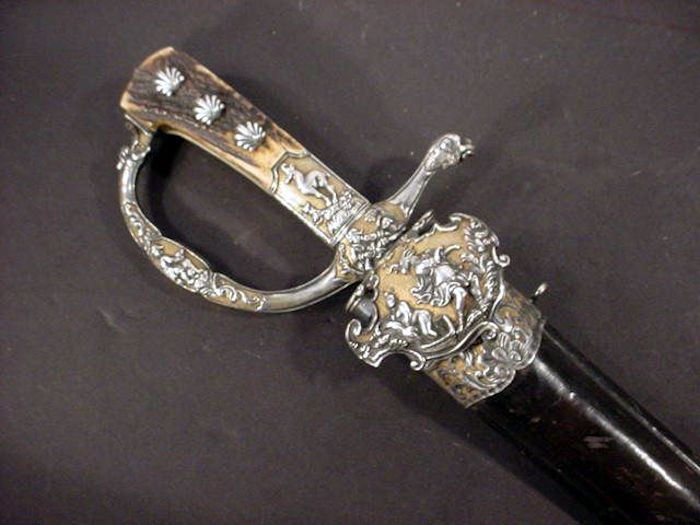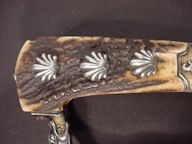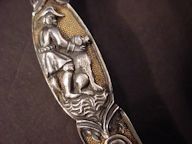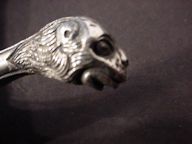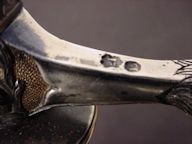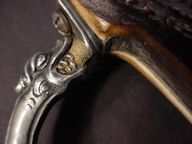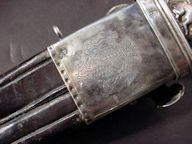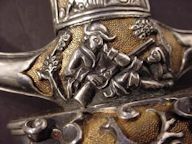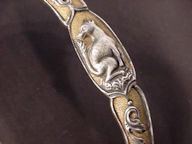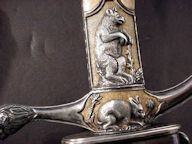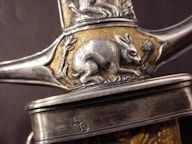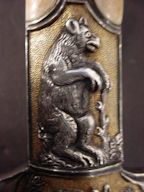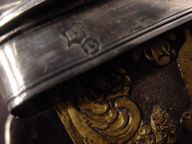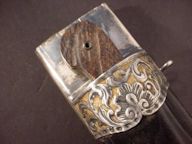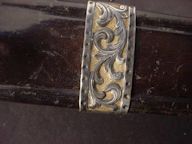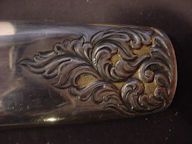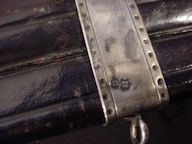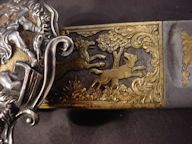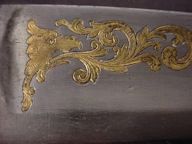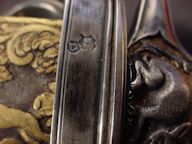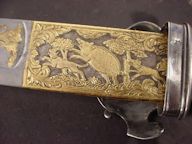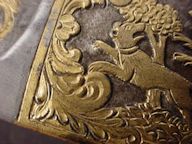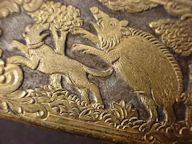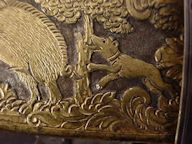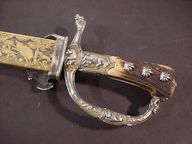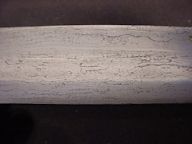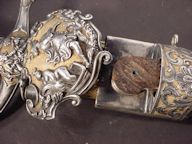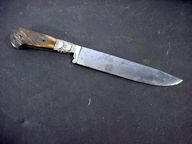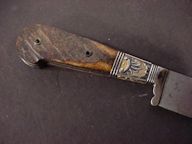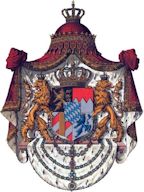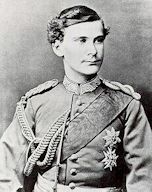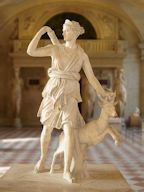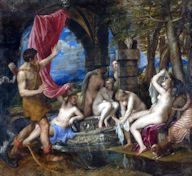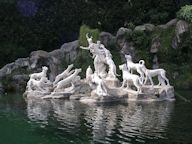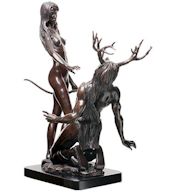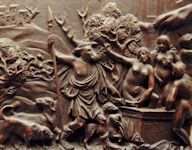|
|
|
|
Special Entry
Royal Wittelsbach's Hunting Sword
|
|
|
|
|
Probably the finest, greatest royal dynasty hunting sword ever offered to collectors (Special) |
|
DESCRIPTION: Here is absolutely the most gorgeous and historically important German edged weapon we have ever seen and—fortunately—have procured. Other than the famed Prince Adalbert falconry dagger we believe that there is no noted hunting piece that could be deemed to even start to compare with it. Holding it in your hands sends a message of majesty and romantic sensations through the mind. This Jagdschwert, or hunting sword, is definitely from the Wittelsbach Bavarian Dynasty, the family that reigned as dukes, electors, and kings of Bavaria from 1180 to 1918. The family provided two Holy Roman emperors 1328-1347/1742-1745. Otto VI after serving the German King Frederick Barbarossa I was invested as Duke of Bavaria as Otto I in 1180 and from that date until 1918, Bavaria was ruled by the Wittelsbach family. It was one of the oldest royal families in Germany. Engraved in the throat of the scabbard (backside) is the official seal or crest of the family. When this coat of arms is seen in color it carries the symbols of the Wittelsbach districts (Regierungsbezirke). It contains the Rake of Franconia, the lions of Swabia, and the checkerboard-looking blue and white colors of Bavaria. (Depending on which of the municipalities used it, there can and usually will be variations.) The most famous member of this illustrious family was Ludwig II, the fairytale king whose numerous castles in the Bavarian Alps still impress visitors today. Also, the beautiful Empress of Austria—worldwide known as “Sissi”—came from a collateral line of the Wittelsbach family. As for Ludwig II, called the Swan King, his dates are 25 August 1845 to 13 June 1886, when he was King of Bavaria from 1864 until his mysterious death in 1886. He was a devoted patron of the composer, Richard Wagner, and that is clearly reflected in the wonderful trappings, paintings, furnishings, bronzes, etc., all with mythological scenes from the Wagnerian operas in his favorite castle Neuschwanstein. Most of the art is derived from Teutonic legends, but the sagas of other ancient cultures are also evident because King Ludwig was a man obsessed with mythology and antiquity and when you look at the details of this magnificently decorated weapon that is in our possession you cannot help but relate it to the king’s taste in this romantically inspired sword. The era of the sword is definitely in the 1880s and with its Wittlesbach escutcheon and crest so evident as well as the rest of the animal portrayals, it is obviously evident that this is no ordinary hunting sword. It has to be a weaponry masterpiece and possibly from a member of the royal family or perhaps from a wealthy member of the royal hunting associations. It’s for sure that among the dark, wood panels of the castle’s interior there are painted scenes of hunting. Schloss Linderhof was the smallest castle built under Ludwig. It’s a Rococo hunting lodge that the Royal hunters reserved for their own use and is deep in the forest of one of the wild valleys of the Ammergau Alps. It has been a German hunting tradition for centuries to hunt wild boar with a Hirschfanger (deer knife) or a Jagd-schwert, or hunting sword. In the early days hunters on horseback would slay a deer with the sword. As the tradition became more and more popular through the ages the weapons used for this sport became more and more ornate and expensive and were used by the royalty and wealthy landed gentry. Many royal hunting parties were launched from Ludwig’s castles especially from the hunting lodge known as “Jagdschloss Schachen.” It’s not known if Ludwig actually hunted, but several hunting clubs for the very wealthy were established in his name and he was known to be a patron of the sport. Certainly it can be more than simply extrapolated from all this consideration that this fantastic sword had connections to the Wittlesbach Dynasty and very possibly was owned by a member of the royal family. The Hunting Sword This is one of the longest swords of this style we have ever encountered—almost 34 inches long in its scabbard with a blade of 28 inches in length. All the metal parts are in 8125 silver and stamps throughout are seen with the numeral “13” profusely applied or stamped. This is nickel silver of the finest grade. Our images show just a few of the stamps that are spread over all the silver parts. The grip is of Hirschhorn, or stag horn, beautifully cut and fitted and has an engraved, decorative pommel top. On both sides are seen three silver clamshells arranged running down and placed upon the horn grips. The weapon has a D-shaped hand guard formed with a dragon’s head clutching the grip. In the middle of this configuration is a scene of a hunter with his hunting hound in a panel and on the other side of the D-guard is a figure of a fox. At the place where the horn ends on the grip is a proud roebuck standing majestically, and if you look closely the half-moon hairpiece belonging to the Roman Goddess Diana can be seen upon the rock formation that the animal stands on. In equal position on the back you can see a bear in sort of a comical stance. Below the roebuck on the front is a scene of a hunter half asleep with his dog probably awaiting the game. Equally on the back is a hare having his lunch of juicy plants. At the end or tip of the extended crossguard is a panther’s head and most noticeably of all is the clamshell guard. It’s the most elaborate one that I have ever seen in the fact that its Rococo beauty depicts the story of Diana and Actaeon from Greek mythology. The Greek Goddess Artemis (Roman equivalent is Diana) is said to be a daughter of Zeus and Letto. Diana is one of the prominent goddesses and the lore that surrounds her is as colorful as she was proclaimed to be. The hunter, Actaeon, met his death because of a curse by the Goddess Diana. Actaeon was the son of Aristaeus and on his father’s side, the grandson of Apollo. One day when hunting with his dogs in the mountains, he came across the beautiful Diana bathing naked in a stream and as the legend goes no man was allowed to see the goddess unclothed. She was extremely angry and splashed water on Actaeon. He turned into a stag, and his dogs, no longer recognizing him, tore him to pieces and ate him. This was the legend and the master sword maker has treated it rather whimsically, but in a most marvelous portrayal. You can see that the background color of all these panels depicting the animals and the legend bear a golden hue. Only the most expensive weapons of the day reflected this treatment. This sword probably cost a great deal more in the money of the era than it is comparatively priced at today. Something like a king’s ransom, no doubt. Clearly no middle-class huntsman could possibly afford it. Now, after describing the beautiful outside decoration we now call your attention to the awesome blade. One third of this blade is covered with an actual gold applique with hunting scenes featuring stags and bear being pursued by hunting hounds. This gold work is so fine as to be raised to the touch. These scenes are framed in two panels measuring 3 inches by 1¼ inches. In front of these panels can be seen long, floral scrolls that flow from the mouths of fierce dragons. The rest of the blade is crafted in fine Damascus steel. What more is possible to describe on this wonderful piece? Well, the skinning knife that is in a pocket below the clamshell guard with its mythological theme is equipped with stag grips, but is also covered with more similar engraving and in its décor it follows the floral theme of the great sword (See images). The silver pocket that it fits into is decorated with further floral depictions with that gilded background. The center band follows this theme, as does the scabbard boot. The scabbard is in black leather sewn together in precision leatherwork. Now! Furthermore on the back of the scabbard throat is the Wittlesbach coat of arms and it is exquisitely and intricately engraved. The crest is flanked by cheery cherubs while the Bavarian crown surmounts the theme. The lions and checkerboard patterns interface in the center. Although, as we have said, there were several variations of the coat of arms of the House of Wittlesbach, and this one most closely resembles the crest of Ludwig II. So, here we present a hunting sword fit for an elector, prince, king, or a man of great worth and we offer it to the fortunate collector. PRICE: Price on Request; serious inquiries only |
Contact Us
Please E-mail for any additional information you may need.
If you prefer, contact 'Germania' at PO Box 68, Lakemont, GA 30552
or call at 706.782.1668.
Please! do not call during the wee hours of the morning. The best time for calling us is between 10 am and 12 noon and between 9 and 11 pm eastern time.


